When it comes to boosting your metabolism, burning calories, and sculpting lean muscle, getting more protein in your diet is key. However, health isn't just about looks; it's also about warding off serious conditions like diabetes, heart attacks, and more, all of which are scientifically linked to diet quality.
So, how can you increase your protein intake while balancing other nutritional needs, especially if weight loss is your goal? That's where high-protein superfoods come into play. Superfoods are nutritional powerhouses that can help you achieve your health and fitness goals, including eating more protein.
What puts the 'super' in superfoods?
While there is no formal definition for superfoods, this term generally refers to "a nutrient-rich food considered to be especially beneficial for health and well-being," says Amy Goodson, MS, RD, CSSD, LD, author of The Sports Nutrition Playbook and member of our Expert Medical Board.
Although the term has a subjective connotation, superfoods do share a few common characteristics. "Think of it as a food that provides more than just carbohydrates, protein, fat, vitamins, or minerals; it's a food that has added nutritional benefit," explains Goodson.
"Examples [of the added nutritional benefits of some superfood] would include antioxidants, as they help fight free radicals in the body that can potentially cause damage to our cells," adds Goodson. "[Also,] an omega-3 fatty acid because it can help buffer free radicals that cause inflammation in the body, as well as help raise HDL ('good' cholesterol). So, [they are] foods that have a greater nutritional capacity than just the basics."
The power of high-protein superfoods
Protein stands out as a key component of superfoods due to its role in organ health, tissue building, and muscle repair. It is also considered a key foundational element in bone, skin, muscle, and cartilage formation.
Combining protein's superpowers with the diverse array of vitamins and nutrients found in superfoods will help you fortify your overall health in several fantastic ways. But which high-protein superfoods can offer more than just your friendly neighborhood superfoods?
Keep reading to learn more about some of the healthiest high-protein superfoods you can eat, plus delicious, creative tips to help you incorporate more of them into your diet with ease.
Chicken breast
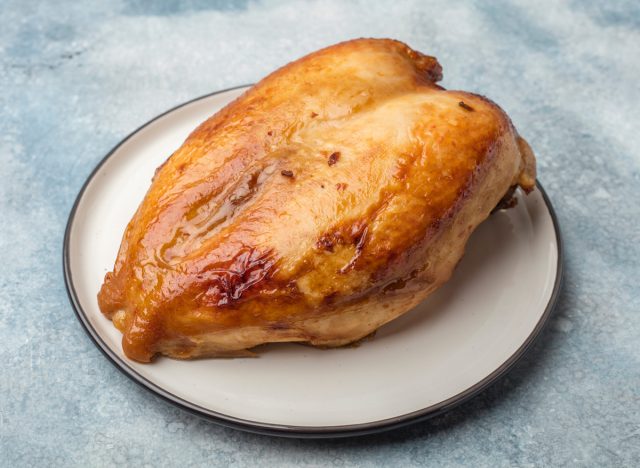
CALORIES: 120
FAT: 1 g (Saturated Fat: 0 g)
SODIUM: 75 mg
CARBS: 0 g (Fiber: 0 g, Sugar: 0 g)
PROTEIN: 26 g
What makes this high-protein superfood so super: People often think of protein and a lower fat content when they think of chicken breast, but this poultry product has many superfood qualities. Containing niacin, selenium, vitamins B12 and B6, zinc, and potassium, chicken breast is a great high-protein superfood to add to your diet.
Chicken is also a "complete" protein. "'Complete protein' means it provides all of the essential amino acids that your body cannot make. This includes all animal foods/proteins, [like] meat, pork, poultry, fish, dairy, eggs," says Goodson.
How to enjoy this superfood: There are a ton of ways to enjoy chicken breast, whether that's in a stir-fry, casserole, bake, chicken salad, or "fried" in the air fryer. If you go the route of buying pre-sliced chicken breast from the deli, just make sure to check the preservatives used and sodium levels, as these can get quite high in packaged chicken products.
Turkey
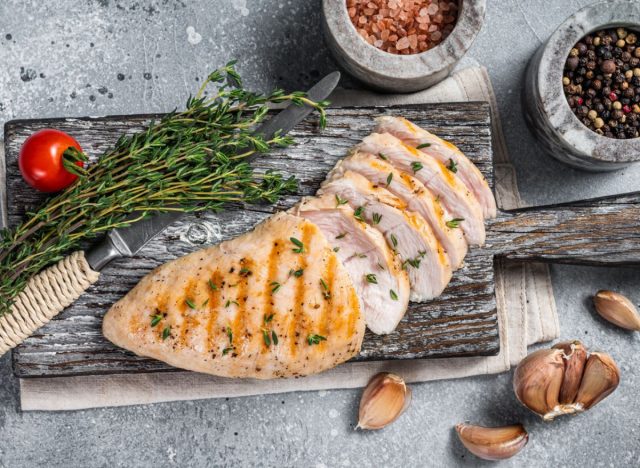
CALORIES: 125
FAT: 1.8 g (Saturated Fat: 0.5 g)
SODIUM: 84 mg
CARBS: 0 g (Fiber: 0 g, Sugar: 0 g)
PROTEIN: 25.6 g
What makes this high-protein superfood so super: Another great poultry food to incorporate into your diet is turkey, which not only has over 25 grams of protein per serving but also contains several helpful nutrients, too. A serving of turkey contains B vitamins like B3, B6, and B12, as well as selenium, phosphorous, zinc, and magnesium—all crucial nutrients to have in a balanced, healthy diet.
How to enjoy this superfood: You can eat turkey breast on sandwiches or in casseroles, or you can include ground turkey in soups, scrambles, burgers, and pasta dishes like this Turkey Bolognese. In the same way that we recommend watching your sodium levels and preservatives used when shopping for pre-sliced chicken breast, we suggest doing the same when buying pre-sliced turkey.
Tofu
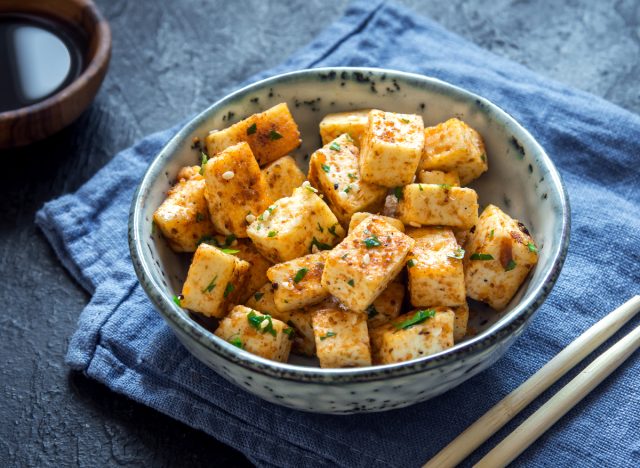
CALORIES: 71
FAT: 3.5 g (Saturated Fat: 0.6 g)
SODIUM: 0.6 mg
CARBS: 0.8 g (Fiber: 0.8 g, Sugar: 0.3 g)
PROTEIN: 9.1 g
What makes this high-protein superfood so super: Tofu is a high-protein superfood that is perfect for plant-based eaters, and aside from the fact that it provides 9 grams of protein per serving, it is also considered a complete protein, meaning it provides all nine essential amino acids that your body can't make on its own. Not only is it rich in protein, but a serving of tofu contains around 50% of your daily value of both calcium and manganese, as well as moderate amounts of selenium, iron, zinc, and vitamin A.
How to enjoy this superfood: There are many ways to eat tofu in your diet. You can bake it, stir-fry it, add it to scrambles, or put it in a smoothie to add a smooth texture and protein boost.
Walnuts
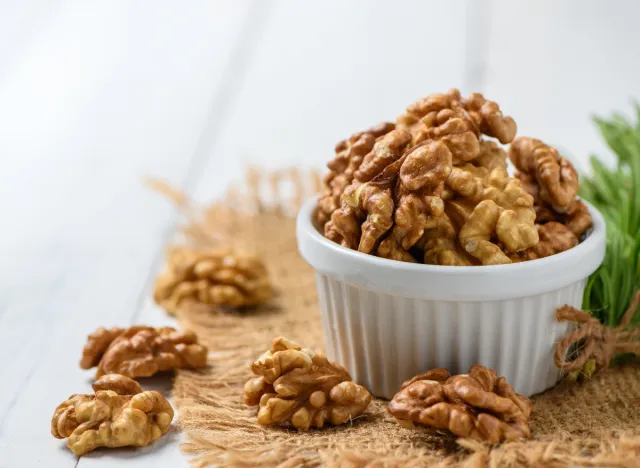
CALORIES: 185
FAT: 18.5 g (Saturated Fat: 1.7 g)
SODIUM: 0.6 mg
CARBS: 3.9 g (Fiber: 1.9 g, Sugar: 0.7 g)
PROTEIN: 4.3 g
What makes this high-protein superfood so super: Walnuts contain over 4 grams of protein per 1-ounce serving, but where they really shine is their healthy fat content. This nut is high in omega-3 fatty acids—specifically ALA, which is the type of omega 3s found in plant sources. According to the National Institutes of Health, a serving of walnuts meets the daily recommended requirements of ALA.
Along with being rich in healthy fats and protein, walnuts also contain high levels of antioxidants like vitamin E and polyphenols.
How to enjoy this superfood: Enjoy a handful of walnuts on their own, or throw some onto your morning yogurt or bowl of high-protein oatmeal.
Tuna
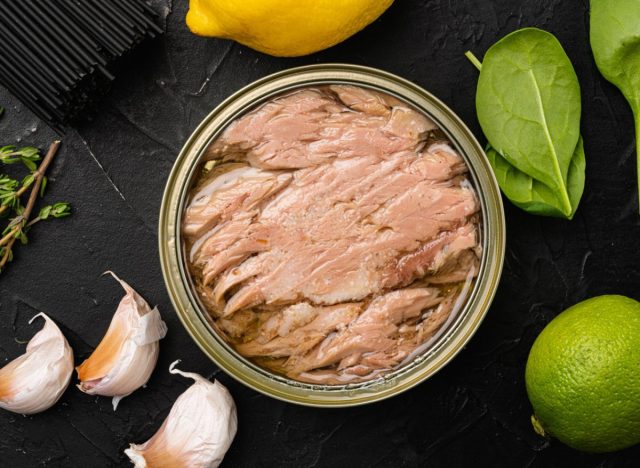
CALORIES: 109
FAT: 2.5 g (Saturated Fat: 0.7 g)
SODIUM: 320 mg
CARBS: 0 g (Fiber: 0 g, Sugar: 0 g)
PROTEIN: 20.1 g
What makes this high-protein superfood so super: Aside from being packed with protein (about 20 grams per serving of canned tuna), tuna is full of healthy omega-3 fatty acids—which are healthy fats necessary for eye, heart, and brain health. You'll also get a helpful dose of selenium, which can boost immunity and help your thyroid health.
How to enjoy this superfood: You can use canned tuna to make a tuna salad like this one from Illana Mulstein, or you can use it in sushi bakes, noodles, and casseroles. One thing to note is that with canned tuna there is always a risk of mercury poisoning, but some types are known to contain higher levels than others, such as albacore and blue tin.
Eggs
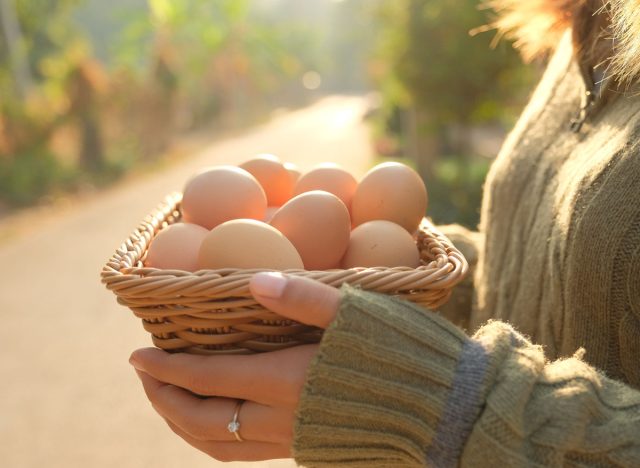
CALORIES: 71.8
FAT: 4.6 g (Saturated Fat: 1.6 g)
SODIUM: 71 mg
CARBS: 0.4 g (Fiber: 0 g, Sugar: 0.2 g)
PROTEIN: 6.3 g
What makes this high-protein superfood so super: "At around 78 calories, one large egg offers 6 grams of high-quality protein that keeps you feeling full," says Mara McStay, MS, RD. Eggs are also loaded with more than a dozen vitamins and minerals, including choline, selenium, and vitamin D. The antioxidant content of eggs also contributes to its superfood status. Eggs are a versatile food, simple to prepare and delicious."
"An egg provides choline, a nutrient important for brain health including memory, thinking, mood, and more," says Goodson. "It also provides lutein and zeaxanthin, two nutrients that are important for high health and can help protect your eyes from blue light emitted from screens."
How to enjoy this superfood: Scrambled, poached, or used in an omelet, there's an egg recipe out there for almost everyone. Level up this high-protein superfood's nutritional impact by combining it with vegetables and whole-grain toast, with this recipe from Ilana Mulstein.
Pistachios
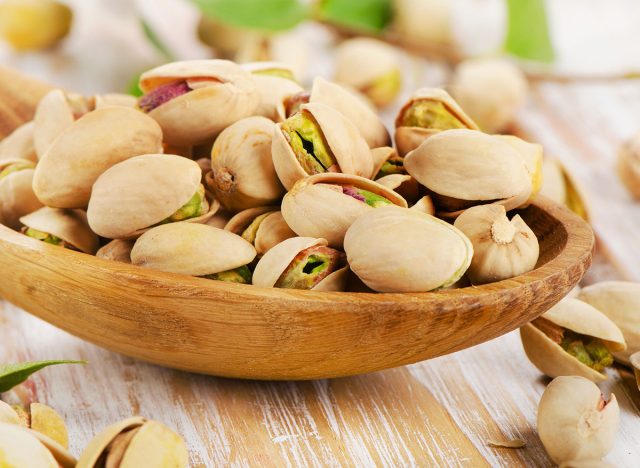
CALORIES: 159
FAT: 12.8 g (Saturated Fat: 1.7 g)
SODIUM: 0.3 mg
CARBS: 7.7 g (Fiber: 3 g, Sugar: 2.2 g)
PROTEIN: 5.7 g
What makes this high-protein superfood so super: "Pistachios are a superfood that contains protein," says Lauren Manaker, MS, RDN, registered dietitian and author of The First Time Mom's Pregnancy Cookbook and Fueling Male Fertility. "Not only are people getting protein when they eat these nuts, but they are also getting a boost of antioxidants, fiber, and phytonutrients."
Research shows that pistachio consumption is said to have anti-inflammatory properties and has been linked to improved cognitive function and beneficial outcomes in instances of high blood pressure, diabetes, cardiovascular disease, and even cancer.
How to enjoy this superfood: For a savory high-protein superfood-fueled snack, try our recipe for BBQ-Flavored Double Roasted Pistachios.
Lean beef
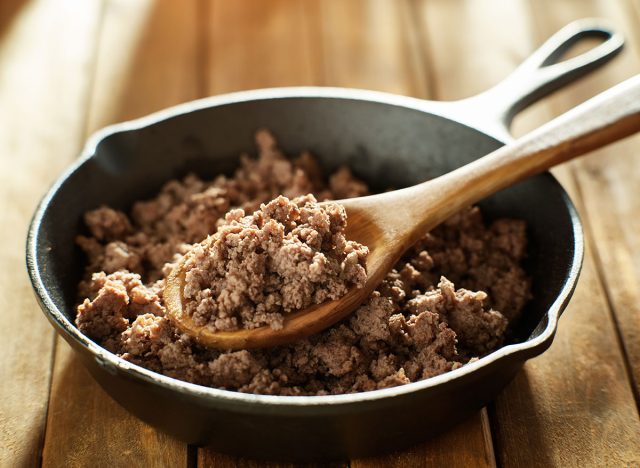
CALORIES: 172
FAT: 7.9 g (Saturated Fat: 3.6 g)
SODIUM: 74.6 mg
CARBS: 0 g (Fiber: 0 g, Sugar: 0 g)
PROTEIN: 23.5 g
What makes this high-protein superfood so super: "Lean beef is one of the best sources of zinc and iron—two nutrients that many people are not getting enough of in their diets," says Manaker. "Plus, the protein found in lean beef is highly absorbable, too."
"Beef provides 10 essential nutrients, including the superfood component antioxidant selenium, which can help fight free radicals in the body," adds Goodson. "It is also an excellent source—providing 20% or more of the Daily Value (DV)—of the following nutrients: vitamin B12, zinc, iron, niacin, and vitamin B6," she says. "Vitamin B12 is mostly found in animal foods, and beef is a big provider of it."
How to enjoy this superfood: Simple to prepare, make Taco Tuesday a high-protein superfood fiesta with our recipe for Steak Tacos.
Lentils
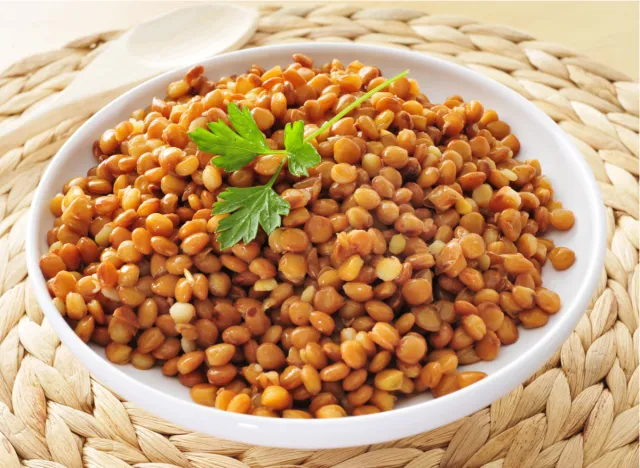
CALORIES: 115
FAT: 0.4 g (Saturated Fat: 0.1 g)
SODIUM: 2 mg
CARBS: 19.9 g (Fiber: 7.8 g, Sugar: 1.8 g)
PROTEIN: 9 g
What makes this high-protein superfood so super: This high-protein superfood contains 9 grams of protein per serving, and its high-fiber content lends itself to supporting healthy digestion. Lentils are also low in sodium, saturated fat, and contain polyphenols, which studies show are associated with antioxidant activities.
How to enjoy this superfood: This high-protein superfood takes center stage with our delicious Healthy Simmered Lentils recipe.
Salmon
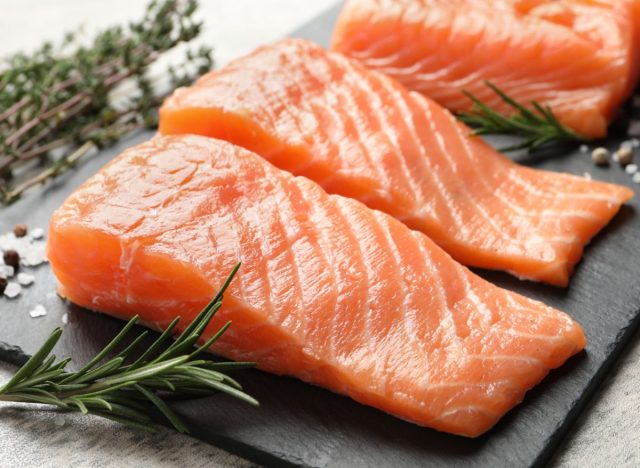
CALORIES: 121
FAT: 5.4 g (Saturated Fat: 0.8 g)
SODIUM: 37.4 mg
CARBS: 0 g (Fiber: 0 g, Sugar: 0 g)
PROTEIN: 16.8 g
What makes this high-protein superfood so super: "Salmon is a source of high-quality protein that also fuels the body with good fats and a slew of micronutrients," explains Manaker.
"Incorporating salmon into your diet is a must-have high-protein superfood," adds Dani Lebovitz, MS, RDN, a pediatric dietitian and founder of Kid Food Explorers. "This versatile fish packs 25 grams of protein per 3.5 ounces, along with omega-3 fatty acids, and is an excellent source of B vitamins important for red blood cell production and converting food into energy."
"Salmon is one of the best sources of omega-3 fatty acids in the diet—its true superfood component. Omega-3s are the heart-healthy fats that can help increase HDL (or 'good' cholesterol), and can help buffer the free radicals that can contribute to inflammation in the body," says Goodson. "Salmon also is a good source of vitamin D, a nutrient that is hard to find in the diet other than in dairy milk. It is also an excellent course of the antioxidant selenium."
Black beans
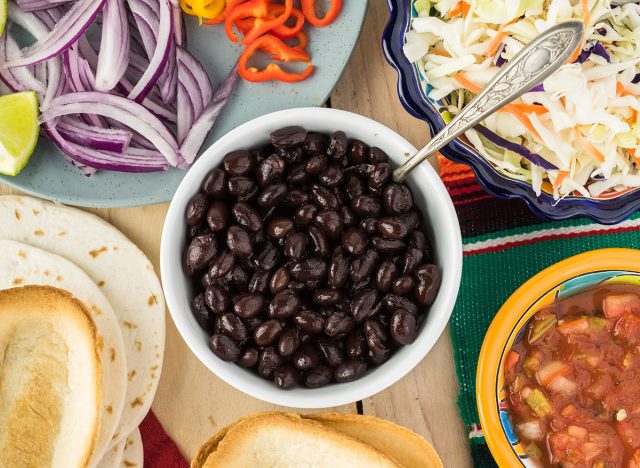
CALORIES: 109
FAT: 0.35 g (Saturated Fat: 0.1 g)
SODIUM: 461 mg
CARBS: 19.9 g (Fiber: 8.3 g, Sugar: 0.3 g)
PROTEIN: 7.3 g
What makes this high-protein superfood so super: "Beans bring it, when it comes to protein and superfood profile. They can promote heart health thanks to their fiber and potassium. Black beans are also rich in anthocyanins which can have antioxidant properties," says registered dietitian Amanda Sauceda, MS, RD.
How to enjoy this superfood: Another high-protein superfood double-whammy, our recipe for a Black Bean Omelet is an ideal breakfast to kick off a productive day.
Kamut
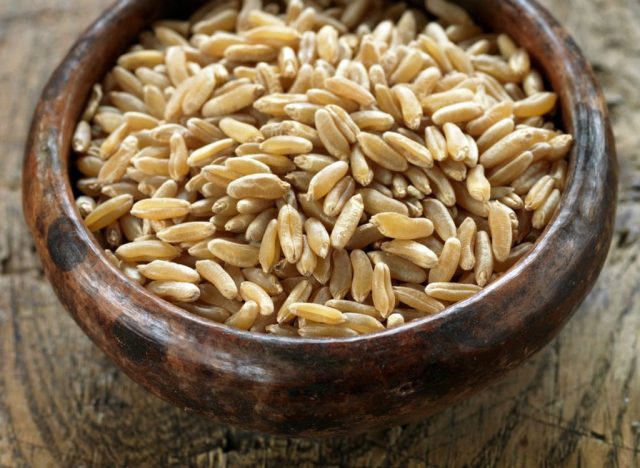
CALORIES: 113.5
FAT: 0.7 g (Saturated Fat: 0.1 g)
SODIUM: 6.9 mg
CARBS: 23.8 g (Fiber: 3.7 g, Sugar: 2.6 g)
PROTEIN: 4.9 g
What makes this high-protein superfood so super: This buttery, nutty grain is not only high in protein, but also selenium, amino acids, and vitamin E. One study published in the European Journal of Clinical Nutrition found that kamut can help reduce blood sugar, LDL (or "bad" cholesterol), and cytokines, which can cause inflammation throughout your body.
How to enjoy this superfood: This ancient grain is a great base for many modern flavors. We recommend a simple yet hearty high-protein superfood-packed kamut pilaf with kale, roasted pumpkin seeds, and roasted squash.
Chickpeas
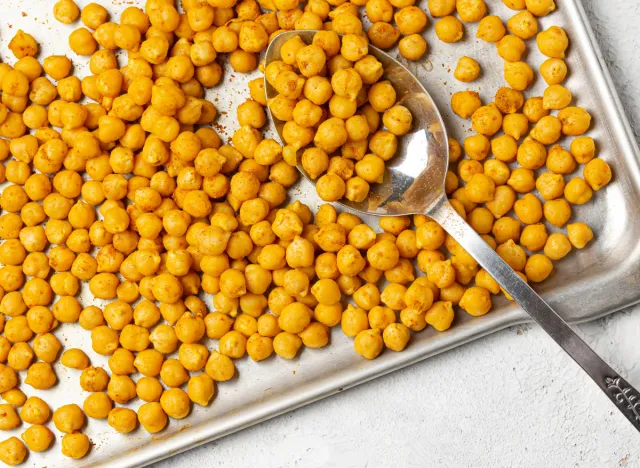
CALORIES: 134.5
FAT: 2.2 g (Saturated Fat: 0.2 g)
SODIUM: 5.8 mg
CARBS: 22.5 g (Fiber: 6.3 g, Sugar: 3.9 g)
PROTEIN: 7.3 g
What makes this high-protein superfood so super: This protein-rich superfood also contains folate, fiber, iron, magnesium, manganese, and phosphorus, among many other vitamins and minerals. Chickpeas are also considered a complete protein because they contain all the essential nine amino acids our bodies need, but cannot make on their own.
Cottage cheese
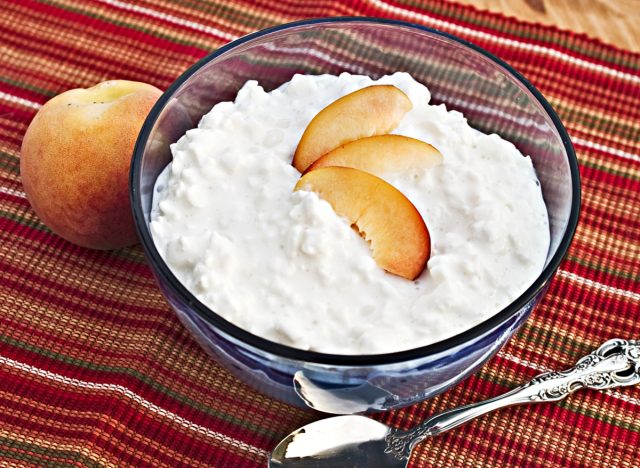
CALORIES: 81.4
FAT: 1.2 g (Saturated Fat: 0.7 g)
SODIUM: 459 mg
CARBS: 3 g (Fiber: 0 g, Sugar: 3 g)
PROTEIN: 14 g
What makes this high-protein superfood so super: "Cultured cottage cheese is a protein-power superfood. Cottage cheese is naturally high in protein, and when it's cultured, it's even better," explains Amanda Sauceda, MS, RD. "A cultured cottage cheese will contain live and active cultures which means you'll get probiotics that can have benefits for your gut and beyond."
Quinoa
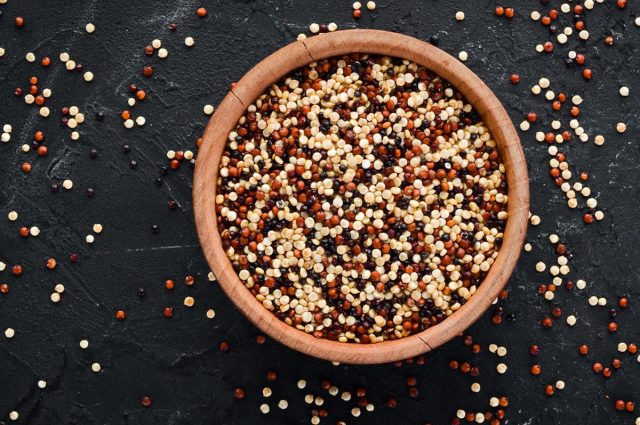
CALORIES: 222
FAT: 3.6 g (Saturated Fat: 0.4 g)
SODIUM: 13 mg
CARBS: 39.4 g (Fiber: 5.2 g, Sugar: 1.6 g)
PROTEIN: 8.1 g
What makes this high-protein superfood so super: Like chickpeas, quinoa also contains all the essential nine amino acids our bodies need but can't produce organically, thus qualifying it as a complete protein. It's also a great source of manganese, phosphorus, vitamin B1, folate, and magnesium, which aids in energy production, muscle function, blood pressure management, and blood sugar control.
Amaranth
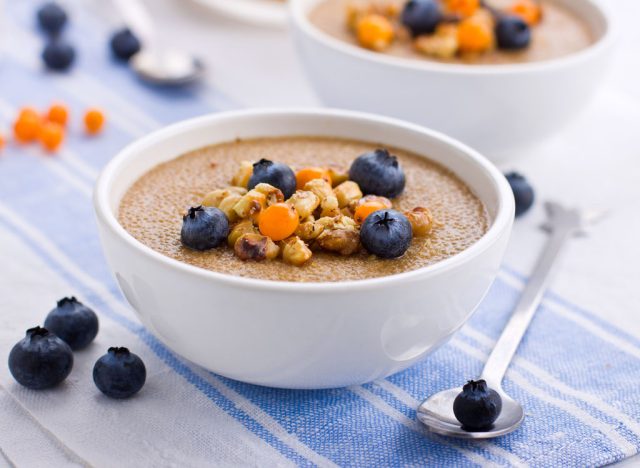
CALORIES: 125
FAT: 1.9 g (Saturated Fat: 0 g)
SODIUM: 7.4 mg
CARBS: 23 g (Fiber: 2.6 g, Sugar: 0 g)
PROTEIN: 4.7 g
What makes this high-protein superfood so super: Whether used in savory pilaf or a sweet porridge, this high-protein grain serves as an excellent source of many vitamins and minerals, like magnesium, calcium, potassium, phosphorus, iron, manganese, and immune system-boosting zinc. Amaranth is also incredibly high in fiber, exceeding the fiber and protein content of both brown rice and wheat. Studies show this superfood has antioxidant properties and can also aid in lowering blood pressure and "bad" LDL cholesterol.
How to enjoy this superfood: More nutritious than even oatmeal, amaranth porridge is a great base to complement a variety of fruits and nuts. You can also thicken the texture and up the protein content even further by adding a dollop of nut butter.
Chia seeds
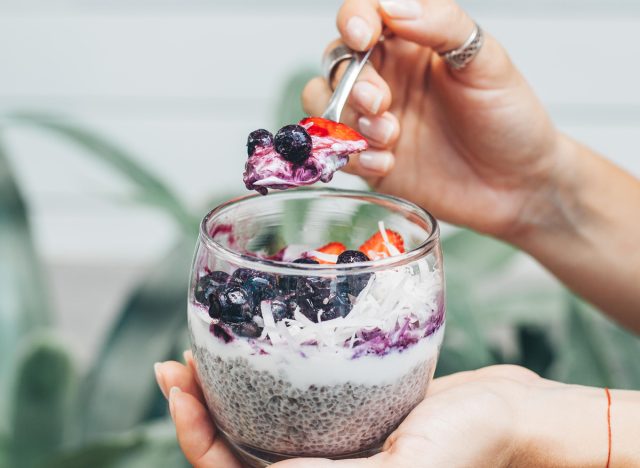
CALORIES: 138
FAT: 8.7 g (Saturated Fat: 0.9 g)
SODIUM: 4.5 mg
CARBS: 12 g (Fiber: 9.6 g, Sugar: 0 g)
PROTEIN: 4.7 g
What makes this high-protein superfood so super: "[Chia seeds have] almost 5 grams of protein per 2 tablespoons, as well as a super nutrient-dense boost of omega-3 fatty acids, powerful antioxidants, vitamins, and minerals, combating inflammation," says Lebovitz.
"Chia seeds are a great protein superfood; 100 grams of chia seeds have 16.5 grams of protein," says Moushumi Mukherjee MS RDN. "It is a great source of fiber, calcium, magnesium, and omega-3s, which makes it a superfood. They offer all nine essential amino acids, making it a great vegetarian protein source."
"[Chia seeds are a] great for anyone trying to stay healthy, lose weight—it keeps you full and has a good amount of fiber," adds Mukherjee. "Chia seeds also have been proven to help with better blood sugar control, and are great for anyone trying to increase fiber in their diet."
Pumpkin seeds
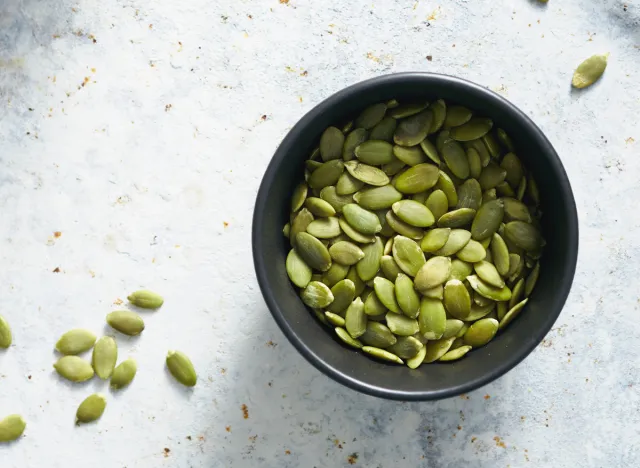
CALORIES: 163
FAT: 14 g (Saturated Fat: 2.4 g)
SODIUM: 5 mg
CARBS: 4.2 g (Fiber: 1.8 g, Sugar: 0.4 g)
PROTEIN: 8.5 g
What makes this high-protein superfood so super: In addition to being high in protein, pumpkin seeds are also high in iron, potassium, phosphorus, magnesium, and zinc. They're also known to be an antioxidant and also have anti-inflammatory, antimicrobial, and anticancer effects on the body, according to many scientific studies.
How to enjoy this superfood: Instead of croutons, add a high-protein crunch to your salad using our recipe for Roasted Pumpkin Seeds. You can also enjoy this superfood straight-up by the fistful as a savory afternoon snack.
Tempeh
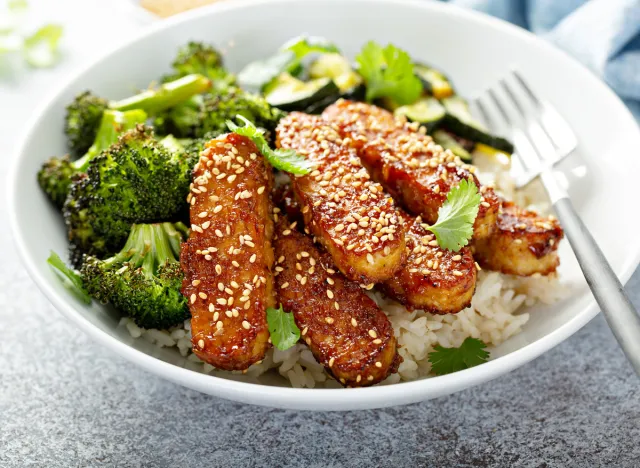
CALORIES: 140
FAT: 3.5 g (Saturated Fat: 0 g)
SODIUM: 340 mg
CARBS: 14 g (Fiber: 5 g, Sugar: 3 g)
PROTEIN: 11 g
What makes this high-protein superfood so super: "Tempeh is a minimally processed fermented soy product. Their nutrient density, high fiber, and low saturated fat content make them a superfood in my book!" says Lori Alizieri Stevens, RD.
"Soy is a great source of B vitamins, especially folate, as well as minerals like calcium and magnesium. [Also,] soy has been linked to reduced risk of some cancers." In fact, one study published in Frontiers in Nutrition noted that greater soy intake was significantly linked to a 10% reduced risk of cancer incidence.
How to enjoy this superfood: Though somewhat bland on its own, tempeh is a great canvas for bold flavors. Tempeh is an incredibly versatile plant-based protein that can be an excellent alternative to meats that tend to be higher in fat, calories, and sodium.
Edamame
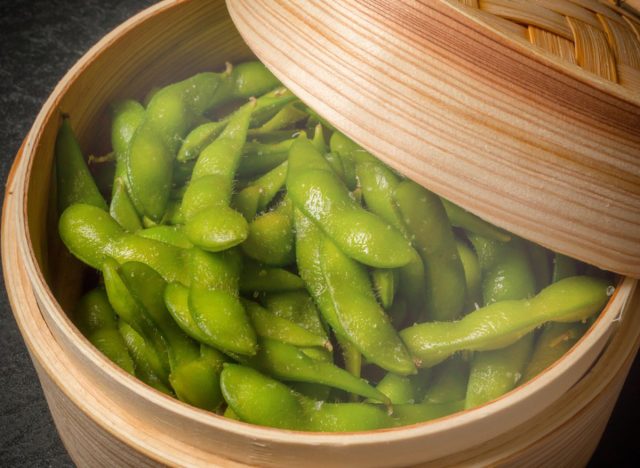
CALORIES: 94
FAT: 4 g (Saturated Fat: 0.5 g)
SODIUM: 4.7 mg
CARBS: 6.9 g (Fiber: 4 g, Sugar: 1.7 g)
PROTEIN: 9.2 g
What makes this high-protein superfood so super: Along with being high in protein, these immature soybeans are another complete protein containing all nine essential amino acids. They are also a superb source of vitamin K, iron, calcium, potassium, magnesium, fiber, and antioxidants. Studies also suggest that they may lower LDL cholesterol, help regulate your blood sugar, reduce the risk for certain cancers, and may even help manage menopausal symptoms.
How to enjoy this superfood: "They can be eaten steamed or roasted for a crunchy snack," says Stevens.
Bone broth
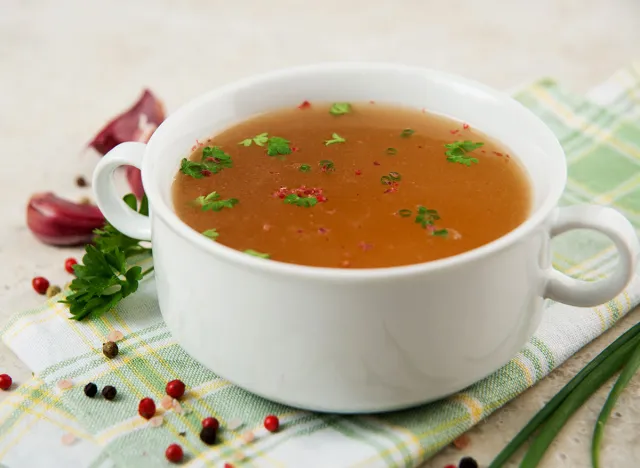
CALORIES: 121
FAT: 7 g (Saturated Fat: 2 g)
SODIUM: 391 mg
CARBS: 4 g (Fiber: 0.9 g, Sugar: 0.9 g)
PROTEIN: 9 g
What makes this high-protein superfood so super: "Bone broth is a high-protein superfood that contains specific amino acids and nutrients linked to decreased inflammation, better gut health, and less joint pain," says Bianca Tamburello, RDN. "And there's more, the collagen and amino acids in bone broth may improve skin elasticity and moisture for a natural glow and promote better sleep."
How to enjoy this superfood: "As a registered dietitian, I recommend Azuluna Farms Chicken Bone Broth because it's pasture-raised and packed with a whopping 14 grams of protein and 8 grams of collagen in just 8 ounces," says Tamburello.
Almonds
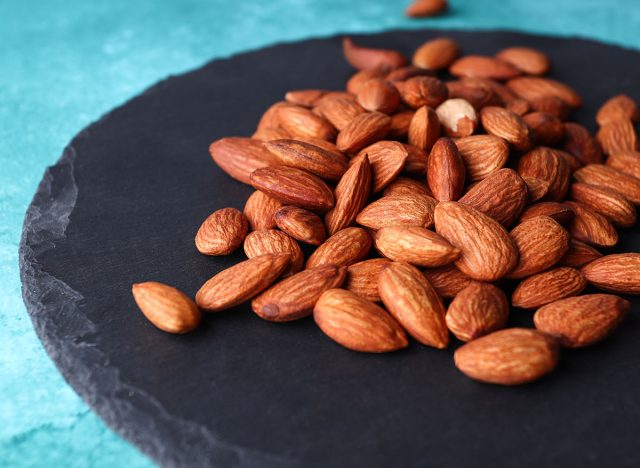
CALORIES: 164
FAT: 14.1 g (Saturated Fat: 1 g)
SODIUM: 0.3 mg
CARBS: 6.1 g (Fiber: 3.5 g, Sugar: 1.2 g)
PROTEIN: 6 g
What makes this high-protein superfood so super: Although almonds may be tiny, their protein-packed punch is mighty. Along with being high in protein, almonds are also rich in antioxidants, healthy fats, vitamins, and minerals—including B2, fiber, manganese, and magnesium. Furthermore, research suggests that these vitamins and minerals have been associated with helping to lower the risk of Alzheimer's, cancer, and heart disease, and can promote healthy blood sugar and blood pressure levels. As a filling and nutrient-dense snack, they can even help you cut calories.
How to enjoy this superfood: Add more texture to your oatmeal or amaranth porridge by tossing in a handful of almonds. They also make a great crunchy gluten-free salad topping in lieu of pita chips or croutons.
Yogurt
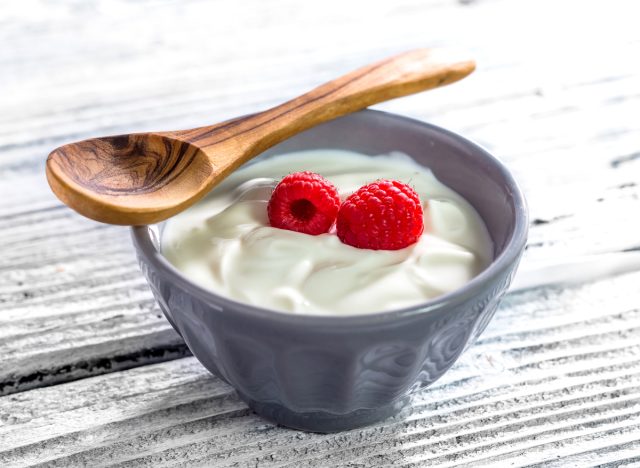
CALORIES: 146
FAT: 3.8 g (Saturated Fat: 2.5 g)
SODIUM: 68 mg
CARBS: 7.9 g (Fiber: 0 g, Sugar: 7.1 g)
PROTEIN: 20 g
What makes this high-protein superfood so super: "One cup (8 ounces) of yogurt provides approximately 12 grams of protein and just under 50% of your daily calcium needs," says Goodson. "Its superfood component is probiotics. These are the live and active bacteria (good bacteria) that promote gastrointestinal health and have been shown to help with digestion as well as reduce negative digestive symptoms like gas, bloating, diarrhea, etc."
For even more protein, you can try a nonfat Greek yogurt, which has around 20 grams of protein for less than 4 grams of fat.
How to enjoy this superfood: For added satiating creaminess in your smoothies, a little yogurt in your blender can go a long way. Or, make a parfait by layering yogurt with fruit and nuts for a sweet, protein-rich treat.
Milk, 1%
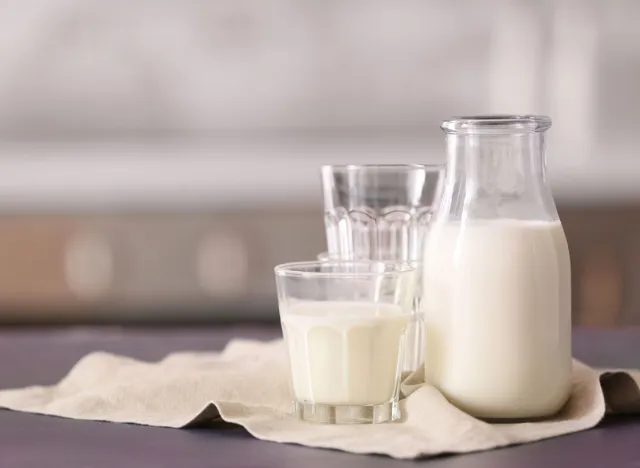
CALORIES: 105
FAT: 2 g (Saturated Fat: 1 g)
SODIUM: 127 mg
CARBS: 12 g (Fiber: 0 g, Sugar: 12 g)
PROTEIN: 8.5 g
What makes this high-protein superfood so super: Milk is both a good source of protein and an excellent source of bone-building calcium and vitamin D (when added) as well as B vitamins, phosphorus, and potassium.
How to enjoy this superfood: Milk can be a great addition to smoothies. For a colorful, superfood-packed breakfast, you can also pour milk over a warm muesli bowl with blueberries, shaved coconut, and roasted pumpkin seeds.
Black-eyed peas
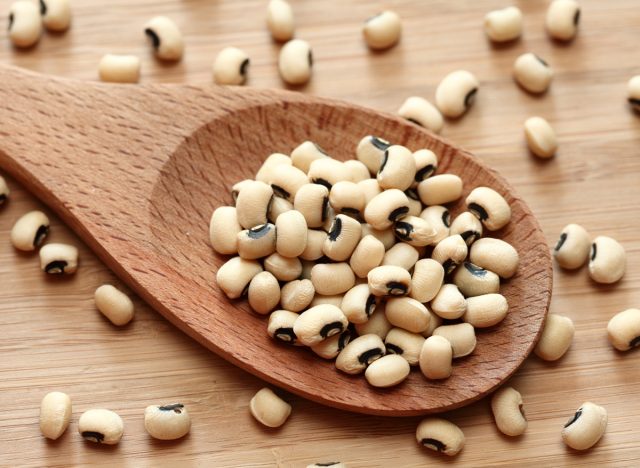
CALORIES: 80
FAT: 0 g (Saturated Fat: 0 g)
SODIUM: 290 mg
CARBS: 14 g (Fiber: 4 g, Sugar: 2 g)
PROTEIN: 5 g
What makes this high-protein superfood so super: Black-eyed peas are not only high in protein, but they also contain about 6 grams of dietary fiber and around 3 grams of iron per cup, equating to 26% and 16% of your Daily Value, respectively. They're also a great source of magnesium, accounting for 21% of your Daily Value for this mineral.
How to enjoy this superfood: Black-eyed peas are a nutritious soul food staple. To capitalize on their benefits, stew with smoky chicken sausage and spices, and serve alongside a sautéed leafy green medley of collard greens and kale—and don't forget the hot sauce!
No comments:
Post a Comment